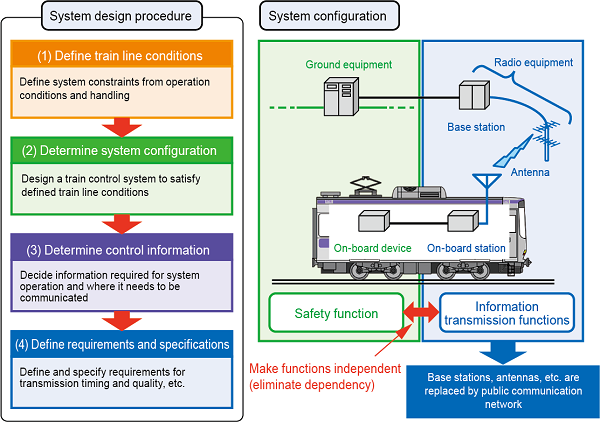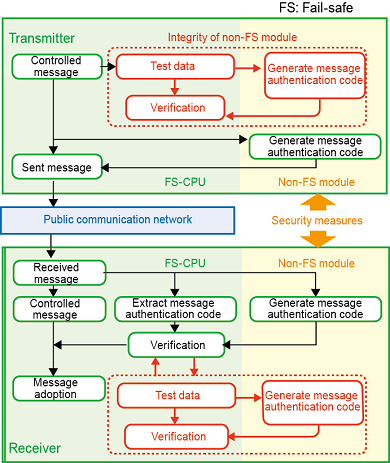13. A method for constructing communication-based train control systems using public communication network
The increasing deployment of communication-based train control systems is helping to increase the efficiency of train operations and reduce the need for ground equipment. In the coming years, use of public communication network such as 5G is expected to further reduce the number of equipment that railway operators need to self-manage, thereby enabling significant savings in design and maintenance work. However, in conventional systems, safety is guaranteed by functions that rely on equipment of private communication network that restrict information transmission. When public communication network is used, on the other hand, there is no specific method for implementing the information security measures necessary to ensure safety.
To address the above issue, we proposed a system configuration that makes information transmission functions, such as base stations, independent of safety-related security control functions of ground and on-board equipment and formulated a procedure for designing a communication-based train control system based on this configuration (Fig. 1). We also defined the safety and information security requirements that such safety equipment must meet to withstand external cyberattacks on the communication network by third parties. As a specific implementation method, we proposed a method for integrating cryptography-based security functions in non-fail-safe modules and diagnosing the normal operation of these functions using test data from each message (Fig. 2). We also conducted a functional verification on a prototype module using a single-board microcontroller. By designing a system based on these methods it becomes easy to make use of public communication network. And by making safety equipment independent of update timing, hardware can be replaced with the latest communications technology and functions can be improved at any time, without compromising security. Depending on operational conditions and system configuration, the total number of ground equipment can be cut by around 50% by eliminating the need for base stations of private communication network and other radio equipment.
The findings of this study were adopted as a basic configuration to future communication-based train control systems by the “Study Group on Communication-Based Train Control Systems” established by the Ministry of Land, Infrastructure, Transport and Tourism and reflected in published guidelines.
Other Contents
- 12. System for determining the degree of deterioration of wooden sleepers using images of railway tracks in front of trains
- 13. A method for constructing communication-based train control systems using public communication network
- 14. Automatic anomaly detection using vehicle condition monitoring data without additional sensors
- 15. An soundness evaluation index and method for dealing with ballasted track that is contaminated with soil
- 16. Method for reducing the frequency of maintenance on standard longitudinal sleepers at boundaries with structures
- 17. Method for evaluating the effect of impact load on fatigue of steel bridges at rail joints
- 12. System for determining the degree of deterioration of wooden sleepers using images of railway tracks in front of trains
- 13. A method for constructing communication-based train control systems using public communication network
- 14. Automatic anomaly detection using vehicle condition monitoring data without additional sensors
- 15. An soundness evaluation index and method for dealing with ballasted track that is contaminated with soil
- 16. Method for reducing the frequency of maintenance on standard longitudinal sleepers at boundaries with structures
- 17. Method for evaluating the effect of impact load on fatigue of steel bridges at rail joints


